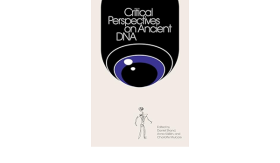This point is perhaps made most clearly in Marianne Sommer and Ruth Amstutz’s chapter, which explores how archaeogenetics—and population genetics more broadly—is based on visual representations that render humanity as divided into discreet, separate “populations.” In spite of the recurring insistence that research on aDNA undermines racism by demonstrating that human history has always been characterized by “admixture” between different groups, the very idea of “admixture” is, in fact, based on the notion of purity.38 As Sommer and Amstutz suggest, archaeogenetics tends to reproduce notions about humanity as divided into different “races.” Thus, while the political transgressions legitimized by aDNA that Magnus Fiskesjö discusses in his chapter are of course perpetrated by actors outside the realm of archaeogenetics itself, the very employment of aDNA to separate groups from each other is fully in line with the logic of a research field that, as we have noted elsewhere, is based on a methodology of differentiation.39 As Fiskesjö’s chapter demonstrates, it is not possible to make a clear distinction between geneticists who create such differentiations and political actors who put them to work. Indeed, as Andreas Nyblom shows in his chapter on the worldwide commotion around the “female Viking warrior,” archaeogenetics is not an insulated, sealed-off laboratory enterprise, but a complex ecosystem in which geneticists and archaeologists operate alongside communicators, journalists, and actors in popular culture and the entertainment business. This ecosystem interconnects university departments, funding agencies, media actors, cultural institutions, and political movements.
All of this shows that the idea of a boundary between archaeogenetics and society cannot be upheld. If it could, aDNA research would not generate the immense public interest that we have seen during the past decade. It would not make any headlines, receive massive funding, or be awarded any Nobel Prizes. But archaeogenetics has always been a high-profile research field thriving by the attention from the public. Unlike most academic disciplines, it has repercussions far beyond the university. Not only does it have the power to unsettle the past and unleash political energies whose consequences it cannot control; not only can it untie groups from their histories and provoke conflicts about land, rights, and identities; as Venla Oikkonen argues in her chapter on the threats and promises of pathogens in the thawing permafrost, it has the capacity to alter our very perception of the future.
Rather than taking the claims of archaeogenetics at face value and submitting to the idea that ancient DNA holds the key to absolute historical truths, it is time that we subject this research field to critical scrutiny.
Notes
1. We want to thank our coeditor, Charlotte Mulcare, as well as Andreas Nyblom and two anonymous reviewers for their critical reading and important inputs to this introduction.
2. For a historic overview of the study of DNA, including the drama surrounding the double helix, which also included scientist Rosalind Franklin, see Siddharta Mukherjee, The Gene: An Intimate History (New York: Scribner, 2016).
3. Dorothy Nelkin and M. Susan Lindee, The DNA Mystique: The Gene as a Cultural Icon (Ann Arbor: University of Michigan Press, 2004).
4. K. Ann Horsburgh, “Molecular Anthropology: The Judicial Use of Genetic Data in Archaeology,” Journal of Archaeological Science 56 (2015): 142.
5. Some examples are Mark Thomas, “To Claim Someone Has ‘Viking Ancestors’ Is No Better than Astrology,” The Guardian, February 25, 2013; “Debunking Genetic Astrology,” University College London, accessed December 19, 2021, https://www.ucl.ac.uk/biosciences/gee/molecular-and-cultural-evolution-lab/debunking-genetic-astrology; Jennifer Raff, “Genetic Astrology: When Ancient DNA Meets Ancestry Testing,” Forbes, April 9, 2019, https://www.forbes.com/sites/jenniferraff/2019/04/09/genetic-astrology-when-ancient-dna-meets-ancestry-testing.
6. See also Nelkin and Lindee, DNA Mystique; Judith Roof, The Poetics of DNA (Minneapolis: University of Minnesota Press, 2007); Josie Gill, Biofiction: Race, Genetics and the Contemporary Novel (London: Bloomsbury Academic, 2020).
7. Russell Higuchi et al., “DNA Sequences from the Quagga, an Extinct Member of the Horse Family,” Nature 312, no. 5991 (1984): 282–284.
8. Svante Pääbo, John A. Gifford, and Allan C. Wilson, “Mitochondrial DNA Sequences from a 7000-Year Old Brain,” Nucleid Acids Research 16, no. 20 (1988): 9775–9887; Erika Hagelberg, Bryan Sykes, and Robert Hedges, “Ancient Bone DNA Amplified,” Nature 342, no. 6249 (1989): 485; Edward M. Golenberg et al., “Chloroplast DNA Sequence from a Miocene Magnolia Species,” Nature 344, no. 6267 (1990): 656–658; Raúl J. Cano et al., “Amplification and Sequencing of DNA from a 120–135-Million-Year-Old Weevil,” Nature 363, no. 6429 (1993): 536–538.
9. Erika Hagelberg and John Brian Clegg, “Genetic Polymorphisms in Prehistoric Pacific Islanders Determined by Analysis of Ancient Bone DNA,” Proceedings: Biological Sciences 252, no. 1334 (1993): 163–170; Anne C. Stone and Mark Stoneking, “Ancient DNA from a Pre-Columbian Amerindan Population,” American Journal of Social Anthropology 92, no. 4 (1993): 463–471; Oliva Handt et al., “Molecular Genetic Analysis of the Tyrolean Ice Man,” Science 264, no. 5166 (1994): 1775–1778.
10. Matthias Krings et al., “Neandertal DNA Sequences and the Origins of Modern Humans,” Cell 90, no. 1 (1997): 19–30.
11. See, for example, Frederika A. Kaestle and K. Ann Horsburgh, “Ancient DNA in Anthropology: Methods, Applications, and Ethics,” Yearbook of Physical Anthropology 119 (2002): 92–130; Mark Pluciennik, “Clash of Cultures? Archaeology and Genetics,” Documenta Praehistorica 33 (2006): 39–49.
12. This technology is also known as second-generation sequencing or high-throughput sequencing.
13. Liisa Loog and Greger Larsen, “Ancient DNA,” in Archaeological Science, ed. Michael P. Richards and Kate Britton (Cambridge: Cambridge University Press, 2020), 13–34; Ludovic Orlando et al., “Ancient DNA Analysis,” Nature Reviews Methods Primers 1 (2021): 1–26. Despite portrayals in the media, whole-genome sequencing does not necessarily mean that an individual’s entire genome is sequenced. What it means is that areas across the whole genome are targeted.
14. Archaeogenomics is also known as paleogenomics. In this text, however, we use the more comprehensive term “archaeogenetics.”
15. Morten Rasmusen et al., “Ancient Human Genome Sequence of an Extinct Palaeo-Eskimo,” Nature 463, no. 7282 (2010): 757–762; Johannes Krause et al., “The Complete Mitochondrial DNA Genome of an Unknown Hominin from Southern Siberia,” Nature 464, no. 7290 (2010): 894–897.
16. Richard Ed Green et al., “A Draft Sequence of the Neanderthal Genome,” Science 328, no. 5979 (2010): 710–722.
17. Ewen Callaway, “Divided by DNA: The Uneasy Relationship between Archaeology and Ancient Genomics,” Nature 555, no. 7698 (2018): 573–576.
18. For a discussion about the “hype” around ancient DNA studies, see Elizabeth D. Jones and Elsbeth Bösl, “Ancient Human DNA: A History of Hype (Then and Now),” Journal of Social Archaeology 21, no. 2 (2021): 236–255.
19. Joyce C. Havstad, “Sensational Science, Archaic Hominin Genetics, and Amplified Inductive Risk,” Canadian Journal of Philosophy 52, no. 3 (2022): 311.
20. See, for instance, Kristian Kristiansen, “Towards a New Paradigm? The Third Science Revolution and its Possible Consequences in Archaeology,” Current Swedish Archaeology 22, no. 1 (2014): 11–34; Rebecca Redfern and Margaret Clegg, “Archaeologically Derived Human Remains in England: Legacy and Future,” World Archaeology 49, no. 5 (2017): 574–587; Theresa L. Cole and Jamie R. Wood, “The Ancient DNA Revolution: The Latest Era in Unearthing New Zealand’s Faunal History,” New Zealand Journal of Zoology 45, no 2. (2018): 91–120; Mary E. Prendergast and Elizabeth Sawchuk, “Boots on the Ground in Africa’s Ancient DNA ‘Revolution’: Archaeological Perspectives on Ethics and Best Practices,” Antiquity 92, no. 363 (2018): 803–815; Pontus Skoglund and Iain Mathieson, “Ancient Genomics of Modern Humans: The First Decade,” Annual Review of Genomics and Human Genetics 19 (2018): 381–404; David Reich, Who We Are and How We Got Here: Ancient DNA and the New Science of the Human Past (Oxford: Oxford University Press, 2018); Matthew Piscitelli, “Bones and Chromosomes: The Ancient DNA Revolution in Archaeology (Part 1),” SAA Archaeological Record 19, no. 1 (2019): 15–17; Éadaoin Harney, “Exploring the Human Past during the Ancient DNA Revolution,” PhD diss., Harvard University, 2020; Logan Kistler et al., “Ancient Plant Genomics in Archaeology, Herbaria, and the Environment,” Annual Review of Plant Biology 71 (2020): 605–629.
21. For academic contexts where the revolution trope has been reproduced, see Brown University’s 2019 conference “The Ancient DNA Revolution in Archaeology” and the seminar in 2022 by Norway’s National Committee for Research Ethics on Human Remains, “aDNA Research and Research Integrity.” For popular science and news media, see, for instance, Robin McKie, “How a DNA Revolution Has Decoded the Origins of Our Humanity,” The Observer, November 19, 2018; Jeffrey Brown, “This Ancient DNA Revolution is Unlocking Just How Interconnected We Are,” PBS.com, June 6, 2018, https://www.pbs.org/newshour/show/the-ancient-dna-revolution-unlocks-how-connected-we-all-are; Noam Hassenfeld and Byrd Pinkerton, “A Scientist on the Great Responsibility of Using Ancient DNA to Rewrite Human History,” Vox, March 24, 2021, https://www.vox.com/22256790/ancient-dna-archaeology-ethics-podcast-unexplainable.
22. Thomas S. Kuhn, The Structure of Scientific Revolutions (Chicago: University of Chicago Press, 1996), 111.
23. Reich, Who We Are, xix.
24. Reich, Who We Are, xviii.
25. For some notable exceptions and critical academic accounts of human archaeogenetic studies, see Elisabeth Niklasson, “Shutting the Stable Door after the Horse Has Bolted: Critical Thinking and the Third Science Revolution,” Current Swedish Archaeology 22, no. 1 (2014): 57–63; Horsburgh, “Molecular Anthropology”; Martin Furholt, “Massive Migrations? The Impact of Recent aDNA Studies on Our View of the Third Millennium Europe,” European Journal of Archaeology 21, no. 2 (2018): 159–191; Christoph Sand, commentary in forum “Ancient DNA and its Contribution to Understanding the Human History of the Pacific Islands,” Archaeology in Oceania 53, no. 3 (2018): 214–215; Susanne E. Hakenbeck, “Genetics, Archaeology and the Far Right: An Unholy Trinity,” World Archaeology 51, no. 4 (2019): 517–527; Alexandra Ion, “Who Are We as Historical Beings? Shaping Identities in Light of the Archaeogenetics ‘Revolution,’ ” Current Swedish Archaeology 27, no. 1 (2019): 11–36; Anna Källén et al., “Archaeogenetics in Popular Media: Contemporary Implications of Ancient DNA,” Current Swedish Archaeology 27, no. 1 (2019): 69–91; Michael L. Blakey, “On the Biodeterministic Imagination,” Archaeological Dialogues 27, no. 1 (2020): 1–16; Anna Källén et al., “Introduction: Transcending the aDNA Revolution,” Journal of Social Archaeology 21, no. 2 (2021): 149–156; Amanda Daniela Cortez et al., “An Ethical Crisis in Ancient DNA Research: Insights from the Chaco Canyon Controversy as a Case Study,” Journal of Social Archaeology 21, no. 2 (2021); John Hawks, “Accurate Depiction of Uncertainty in Ancient DNA Research: The Case of Neandertal Ancestry in Africa,” Journal of Social Archaeology 21, no. 2 (2021): 157–178; Judith Jesch, “Haplotypes and Textual Types: Interdisciplinary Approaches to Viking Age Migration and Mobility,” Journal of Social Archaeology 21, no. 2 (2021): 216–235; Jones and Bösl, “Ancient Human DNA”; Venla Oikkonen, “Conceptualizing Histories of Multispecies Entanglements: Ancient Pathogen Genomics and the Case of Borrelia recurrentis,” Journal of Social Archaeology 21, no. 2 (2021): 197–215; Havstad, “Sensational Science”; Anna Källén et al., “Petrous Fever: The Gap Between Ideal and Actual Practice in Ancient DNA Research,” Current Anthropology (forthcoming). For critical accounts in nonscholarly publications, see Chip Colwell, “Rights of the Dead and the Living Clash when Scientists Extract DNA from Human Remains,” The Conversation, April 6, 2018, https://theconversation.com/rights-of-the-dead-and-the-living-clash-when-scientists-extract-dna-from-human-remains-94284; Gideon Lewis-Kraus, “Is Ancient DNA Research Revealing New Truths—or Falling into Old Traps?” New York Times Magazine, January 17, 2019; Daniel Strand, “0.01%: Genetics, Race and the Methodology of Differentiation,” Eurozine, January 4, 2021, https://www.eurozine.com/0-01.
26. See, for instance, Prendergast and Sawchuk, “Boots on the Ground”; Kirsty Squires, David Errickson, and Nicholas Márquez-Grant, ed., Ethical Approaches to Human Remains: A Global Challenge in Bioarchaeology and Forensic Anthropology (Cham: Springer, 2019); Kendra A. Sirak and Jakob W. Sedig, “Balancing Analytical Goals and Anthropological Stewardship in the Midst of the Paleogenomics Revolution,” World Archaeology 51, no. 4 (2019): 560–573; Jennifer K. Wagner et al., “Fostering Responsible Research on Ancient DNA,” American Journal of Human Genetics 107, no. 2 (2020): 183–195; Songül Alpaslan-Roodenberg et al., “Ethics of DNA Research on Human Remains: Five Globally Applicable Guidelines,” Nature 599, no. 7883 (2021): 41–46. For a critique of this best-practices genre in archaeogenetics, see Krystal S. Tsosie et al., “Ancient-DNA Researchers Write Their Own Rules,” Nature 600, no. 7887 (2021): 37.
27. See, for instance, Elizabeth Sawchuk and Mary Prendergast, “Ancient DNA is a Powerful Tool for Studying the Past—When Archaeologists and Geneticists Work Together,” The Conversation, March 11, 2019, https://theconversation.com/ancient-dna-is-a-powerful-tool-for-studying-the-past-when-archaeologists-and-geneticists-work-together-111127; Keolu Fox and John Hawks, “Use Ancient Remains More Wisely,” Nature 572, no. 7771 (2019): 581–583.
28. However, see the critique voiced by Tsosie et al., “Ancient-DNA Researchers Write Their Own Rules.” See also Natan Elgabsi, “The ‘Ethic of Knowledge’ and Responsible Science: Responses to Genetically Motivated Racism,” Social Studies of Science 52, no. 2 (2022): 303–323.
29. See Bryan Sykes, The Seven Daughters of Eve: The Science that Reveals Our Genetic Ancestry (New York: Norton, 2001), x; Adam Rutherford, A Brief History of Everyone Who Ever Lived: The Human Story Retold through Our Genes (New York: The Experiment, 2017); Reich, Who We Are, xxvi;
30. Sykes, Seven Daughters of Eve, x.
31. See Kim TallBear, Native American DNA: Tribal Belonging and the False Promise of Genetic Science (Minneapolis: University of Minnesota Press, 2013), 4–5.
32. Luigi Luca Cavalli-Sforza et al., “Call for a Worldwide Survey of Human Genetic Diversity: A Vanishing Opportunity for the Human Genome Project,” Genomics 11 (1991): 490–491.
33. Jenny Reardon, Race to the Finish: Identity and Governance in an Age of Genomics (Princeton, NJ: Princeton University Press, 2005); Amade M’charek, The Human Genome Diversity Project: An Ethnography of Scientific Practice (Cambridge: Cambridge University Press, 2005); Jonathan Marks, “ ‘We’re Going to Tell These People Who They Really Are’: Science and Relatedness,” in Relative Values: Reconfiguring Kinship Studies, ed. Sarah Franklin and Susan McKinnon (Durham, NC: Duke University Press, 2001), 355–383.
34. Reich, Who We Are, xx–xxi. See also Anna Källén, “A Family Tree of Everyone,” in The Trouble with Ancient DNA (Chicago: University of Chicago Press, 2024).
35. Reardon, Race to the Finish.
36. Reardon, Race to the Finish; Elgabsi, “Ethic of Knowledge.”





















